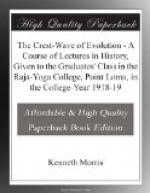In the third Year of his reign Han Mingti dreamed a dream: he saw a serene and “Golden Man” descending towards him out of the western heavens. It would mean, said his brother, to whom he spoke of it, the Golden God worshiped in the West,—the Buddha. Buddhism had first come into China in the reign of Tsin Shi Hwangti; but that imperial ruffian had made short work of it:— he threw the missionaries into prison, and might have dealt worse with them, but that a “Golden Man” appeared in their cell in the night, and opened all doors for their escape. Buddhist scriptures, probably, were among the books destroyed at the great Burning. So there may have been Buddhists in China all through the Han time; but if so, they were few, isolated and inconspicuous; it is Han Mingti’s proper glory, to have brought Buddhism in.
He liked well his brother’s interpretation, and sent inquirers into the west. In 65 they returned, with scriptures, and an Indian missionary, Kashiapmadanga,—who was followed shortly by Gobharana, another. A temple was built at Loyang, and under the emperor’s patronage, the work of translating the books began.—We have seen before how some touch from abroad is needed to quicken an age into greatness: such a touch came now to China with these Indian Buddhists;—who, in all likelihood, may also have been in their degree Messengers of the Lodge.
In the usual vague manner of Indian chronology, the years 57 and 78 A.D. are connected with the name of a great king of the Yueh Chi, Kanishka, whose empire covered Northern India. Almost every authority has a favorite point in time for his habitat; but these dates, not so far apart but that he may well have been reigning in both, will do as well as another. You will note that 72 A.D. (which falls between them) is a matter of thirteen decades from 58 B.C., the date sometimes ascribed to that much-legended Vikramaditya of Ujjain. Or, if we go back to the (fairly) settled 321 B.C. of Chandragupta Maurya, and count forward thirteen-decade periods from that, we get 191 for the end of the Mauryas (it happened about then); 61 for Vikramaditya (which may well be); 69 for Kanishka,—which also is likely enough, and would make him contemporary with Han Mingti. As the years 57 and 78 are both ascribed to him, it may possibly be that they mark the beginning and end of his reign respectively.
We know very little about him, except that he was a very great king, a great Buddhist, a man of artistic tastes, and a great builder; that he loved the beautiful hills and valleys of Cashmere; and that his reign was a wonderful period in sculptue, —that of the Gandhara or Greco-Buddhist School. Again, he is credited (by Hiuen Tsang) with convening the Fourth Buddhist Council: following in this, as in other matters, the example of Asoka. We are at liberty I suppose, if we like, to assign that cyclic year 69 to the meeting of this Council: this year or its neighborhood. So that all




